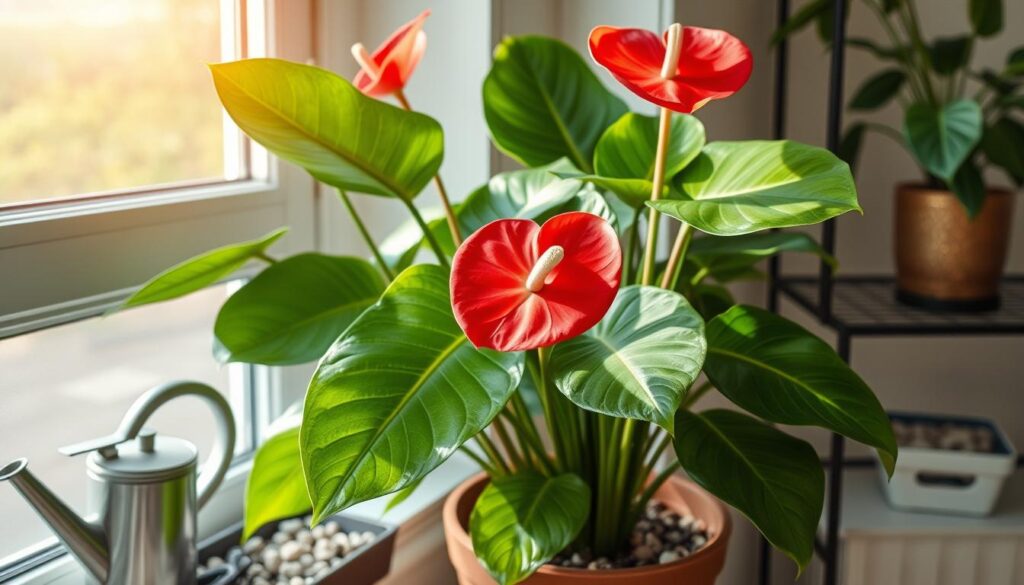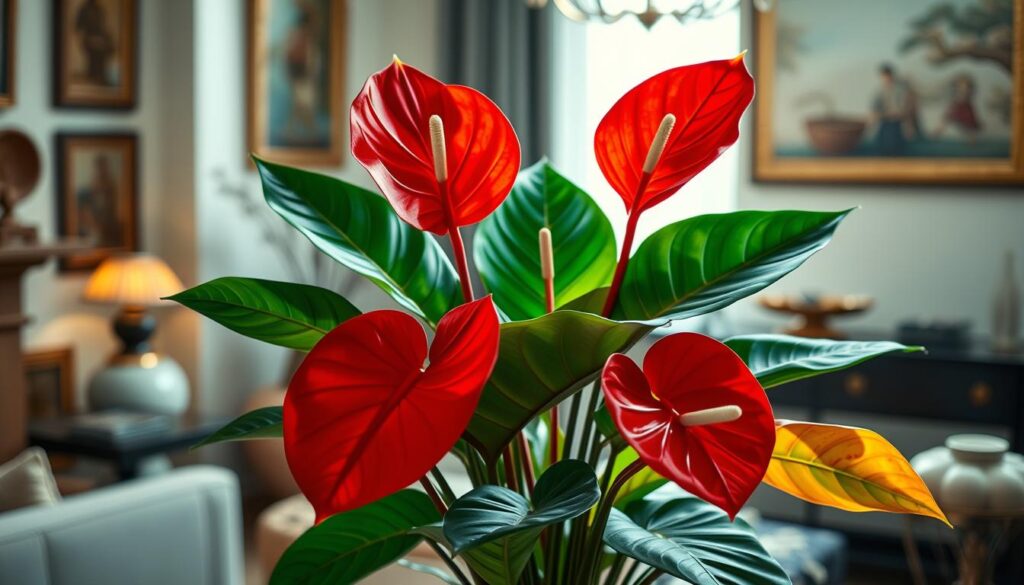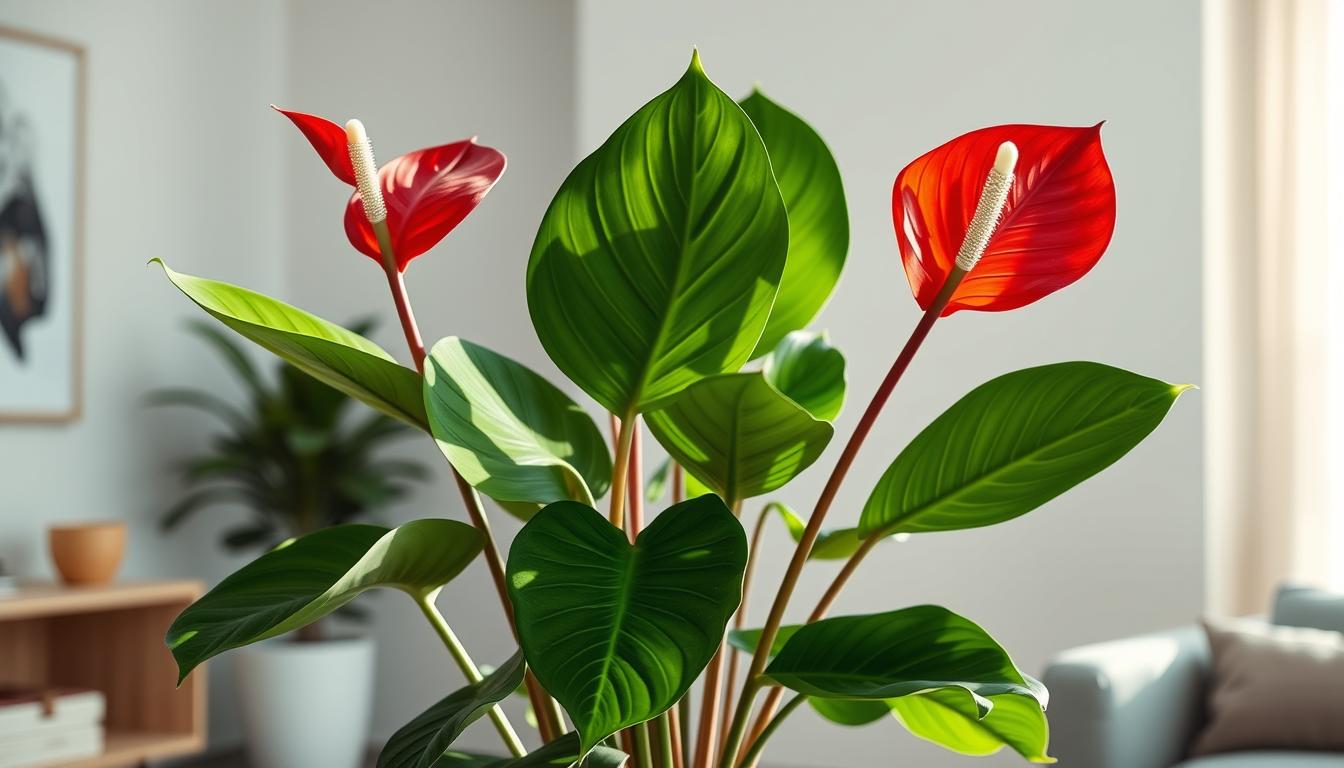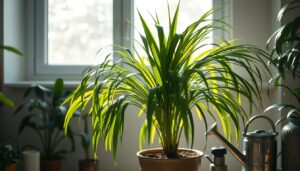Imagine a stunning, long-blooming houseplant that makes any room look elegant. The Anthurium plant is a great pick. It has exotic flower spathes and heart-shaped leaves.
As you learn about Anthurium and Orchid care, you’ll see its beauty and benefits. With the right care, Anthurium thrives indoors. It adds color and texture, a great alternative to traditional Orchid care.
The Anthurium plant comes from Central America, South America, and the Caribbean. It’s a tropical gem that adds warmth and sophistication. Its flowers last long and come in bright colors like red, pink, white, and purple.
It’s perfect for both new and experienced gardeners. Anthurium adapts well to indoor conditions. It needs minimal care, just like Orchids.
Exploring Anthurium reveals its special traits. It purifies the air and loves humid places. With its vibrant leaves and flowers, it’s a great choice for elegance and beauty in your home. Its care is similar to an Orchid’s, making it a wonderful indoor garden addition.
What is an Anthurium?
Anthurium is a flowering plant known for its unique look. It has over 1,000 species. This makes it a diverse group with many plants.
Some popular Anthurium types are Anthurium andraeanum, Anthurium clarinervium, and Anthurium scherzerianum. These plants have striking flowers and soft leaves. They can be grown like orchids.
Here are some key characteristics of Anthurium:
- Glossy, waxy, heart-shaped leaves
- Long-lasting blooms that typically occur in spring and summer
- High humidity requirements, with preferred humidity levels being very high
- Temperature range of 65 to 85 degrees Fahrenheit for optimal growth
Anthurium is a unique plant that can make any room elegant. Knowing its needs helps you care for it well. This way, you can enjoy its beautiful flowers for months.
| Variety | Characteristics |
|---|---|
| Anthurium andraeanum | Striking flower spathes, heart-shaped leaves |
| Anthurium clarinervium | Velvety leaves, long-lasting blooms |
| Anthurium scherzerianum | Corkscrew-like spadices, high humidity requirements |
Benefits of Having an Anthurium at Home
Having an Anthurium at home is great. It purifies the air and looks beautiful. Anthuriums bloom for a long time, adding color and texture to your space. They are easy to care for, unlike some plants.
Some benefits of having an Anthurium include:
- Air purification properties, which can help remove toxins and pollutants from the air
- Aesthetic appeal, which can add a touch of elegance and sophistication to any room
- Long blooming seasons, which can provide a beautiful display of color and texture for months on end
Anthuriums also help reduce stress and anxiety. They can remove bad air like formaldehyde and xylene. They are strong plants and don’t get sick easily with the right care.
| Benefit | Description |
|---|---|
| Air Purification | Removes toxins and pollutants from the air |
| Aesthetic Appeal | Adds a touch of elegance and sophistication to any room |
| Long Blooming Seasons | Provides a beautiful display of color and texture for months on end |
Ideal Growing Conditions for Anthurium
To keep your Anthurium happy and healthy, it needs the right growing conditions. This includes bright, indirect Orchid sunlight, high humidity, and well-draining soil. Knowing these conditions is key for your Anthurium to grow well and bloom.
For Orchid potting, choose a pot that’s just a bit bigger than the plant’s roots. This stops the soil from getting too wet, which can harm the roots. Also, the soil should drain well to avoid waterlogged conditions.
Light Requirements
Anthuriums need about six hours of bright, indirect Orchid sunlight each day. Direct sunlight can burn the leaves. So, place them near a window with a sheer curtain.
Temperature and Humidity
The best temperature for Anthurium is between 65°F and 85°F. They also love high humidity, above 50%. To keep humidity right, mist the plant a few times a week or put the pot on a tray with water and pebbles.
Soil and Watering Needs
Anthuriums need watering about once a week indoors or every two to three days outdoors. Keep the soil moist but not too wet. Also, fertilize with a high-phosphorus liquid fertilizer during the growing season. Orchid watering should be done carefully to avoid overwatering, which can cause root rot.
| Condition | Ideal Range |
|---|---|
| Temperature | 65°F – 85°F |
| Humidity | Above 50% |
| Light | 6 hours of indirect sunlight |
| Watering | Once a week indoors |
How to Care for Your Anthurium
To keep your Anthurium happy, you need to know the basics. It’s like an orchid but needs different care. For example, Orchid care means watching humidity and temperature closely. But, both orchids and anthuriums need careful watering and food to stay healthy.
Watering is key, but so is the right Orchid fertilizer. A balanced fertilizer in the growing season helps your anthurium grow and bloom. But, don’t overdo it, or your leaves might turn yellow.
Routine Maintenance Tips
- Water your anthurium when the top 2 inches of soil are dry.
- Mist the leaves every 2-3 days during spring and summer.
- Repot your anthurium every 2 to 3 years to provide fresh soil and a larger pot if necessary.

Fertilizing Your Anthurium
Fertilizing is important for your anthurium’s health and blooms. Use half-strength fertilizer once a season in spring and summer. This helps it grow and bloom well.
Pruning Techniques
Pruning keeps your anthurium looking good and growing. Cut off dead or dying leaves and flowers. This stops Orchid diseases and helps with Orchid care.
| Season | Fertilization Frequency |
|---|---|
| Spring and Summer | Every 2-4 weeks |
| Fall and Winter | Every 6-8 weeks or stopped altogether |
Common Problems and Solutions
When you care for your Anthurium, you might face some issues. Orchid diseases, Orchid pests, and Orchid stress can happen if you don’t care for it right. It’s key to watch your plant closely to catch problems early.
Look out for sticky leaves, yellow leaves, holes in leaves, webs, and bugs. Orchid pests like mealybugs and spider mites can harm your plant a lot. Orchid diseases like root rot and leaf spot can come from too much water, bad air, and too much humidity.
To avoid these problems, keep your plant in the best conditions. This means watering it right, giving it bright but not direct light, and using soil that drains well. Checking your plant often can cut down pest problems by 70%. Good air flow can lower disease risks by about 60%. These steps help prevent Orchid stress and keep your Anthurium happy and healthy.
- Pest infestations: Use mild soap or neem oil to control infestations
- Diseases: Improve air circulation, reduce humidity, and treat with fungicides if necessary
- Environmental stress: Maintain optimal growing conditions, including proper watering schedules and bright indirect light
| Problem | Solution |
|---|---|
| Pest infestations | Use mild soap or neem oil |
| Diseases | Improve air circulation, reduce humidity, and treat with fungicides if necessary |
| Environmental stress | Maintain optimal growing conditions, including proper watering schedules and bright indirect light |
Propagating Your Anthurium
Learning about Orchid propagation is exciting. You can use Orchid seeds and Orchid division to grow more plants. This way, you can share plants with others or add to your collection.
There are many ways to propagate, like division, layering, and seed. Orchid division is great because it makes many plants from one. But, keep Orchid seeds moist to help them grow.
Methods of Propagation
- Division: This method involves dividing the roots of a mature plant to create multiple new plants.
- Layering: This method involves bending a stem down to the soil and securing it with a rock or wire to create a new plant.
- Seed: This method involves planting seeds in a potting mix and keeping them moist and warm until they germinate.
By trying these methods, you can grow more Anthuriums. This will make your home even more beautiful.
| Method | Success Rate | Time to Root |
|---|---|---|
| Division | High | 4-6 weeks |
| Layering | Medium | 6-8 weeks |
| Seed | Low | 7-30 days |
Decorative Uses for Anthurium
Anthurium is great for decorating your home. You can make Orchid arrangements and Orchid bouquets that look elegant. With over 1,000 types of Anthurium, you can pick the perfect one for your Orchid decor.
In small spaces, one plant can make a big impact. In bigger areas, 4-5 Anthuriums can make it feel like a tropical place. You can also mix Anthurium with other plants for a unique look.
Here are some ways to use Anthurium in decorations:
- Creating a centerpiece in kitchens
- Grouping plants on bookshelves for office spaces
- Placing them in entry hallways to make a positive first impression
A study shows Anthuriums can make your home look better and increase its value by 5-10%. You can learn more at this website.
Anthurium can bloom colorful flowers for months. It’s perfect for any room. Whether you want a Orchid arrangement or a Orchid bouquet, Anthurium is a great choice.
| Plant | Decorative Use | Location |
|---|---|---|
| Anthurium | Centerpiece | Kitchen |
| Anthurium | Grouping | Office space |
| Anthurium | Entry hallway | Entry hallway |
Anthurium in Different Cultures
Exploring Anthurium shows its importance in many cultures. It’s used in Orchid symbolism, Orchid traditional medicine, and Orchid celebrations. For centuries, people have valued Anthurium for its meanings and uses.
In Hawaiian culture, it’s called the “Flamingo Flower.” It’s believed to bring luck and fortune. In Chinese culture, it attracts good vibes and keeps away bad ones. The leaves help with headaches and breathing problems.
Here are some ways Anthurium is used in different cultures:
- In Latin American cultures, it’s used in rituals for love and happiness.
- The sap treats minor wounds and burns.
- Anthurium is also used in Orchid celebrations and ceremonies, showing different feelings and bonds.

In Orchid traditional medicine, Anthurium helps with fever and rheumatism. Its special properties make it valuable. Learning about Anthurium shows its importance in cultures and its uses in life.
| Culture | Significance of Anthurium |
|---|---|
| Hawaiian | Brings good luck and fortune |
| Chinese | Attracts positive energies and protects against negative influences |
| Latin American | Used in rituals to bring love and happiness into homes |
Seasonal Care Tips for Anthuriums
As you care for your Anthurium, remember the seasons change. This affects your plant’s needs. Knowing Orchid seasonal care helps keep your Anthurium healthy all year. In winter, adjust your care to match the plant’s dormant time, like Orchid winter care.
In spring, your Anthurium will grow and bloom. You need to change your watering and feeding. This follows Orchid summer care rules. It helps your plant grow well and bloom.
- Reducing watering frequency during the winter months
- Fertilizing your Anthurium once a month during the growing season
- Providing bright, indirect light for at least 6 hours a day
Follow these tips to care for your Anthurium all year. For more info, visitAnthurium care tips. It will help keep your plant happy and healthy.
Buying an Anthurium
When you buy an Anthurium, you want it to be healthy. Look for plants with shiny leaves and strong stems. A good Orchid nursery will have many types of Anthuriums. The staff should know a lot about them.
The Orchid cost is important too. Prices change based on the plant’s size and type. You might pay $30 to $100 for a good Anthurium. Here’s what can change the price:
- Size: Bigger plants cost more.
- Type: Some Anthuriums are rarer and pricier.
- Quality: Plants that look good and are healthy cost more.
By picking a good Orchid nursery, you can find a great Anthurium. Think about the Orchid cost and any extra costs. This way, you’ll get the most value for your money.
Conclusion: Embrace the Beauty of Anthurium
The Anthurium is a special houseplant. It has orchid-like flowers and cleans the air. It makes any place look and feel better.
Looking after an Anthurium is good for your mind. It helps you feel calm and happy. Its flowers last a long time, adding beauty to any room.
Choose an Anthurium for its beauty and health benefits. It comes in many colors, like red and pink. Adding one to your home or office will brighten your day.




